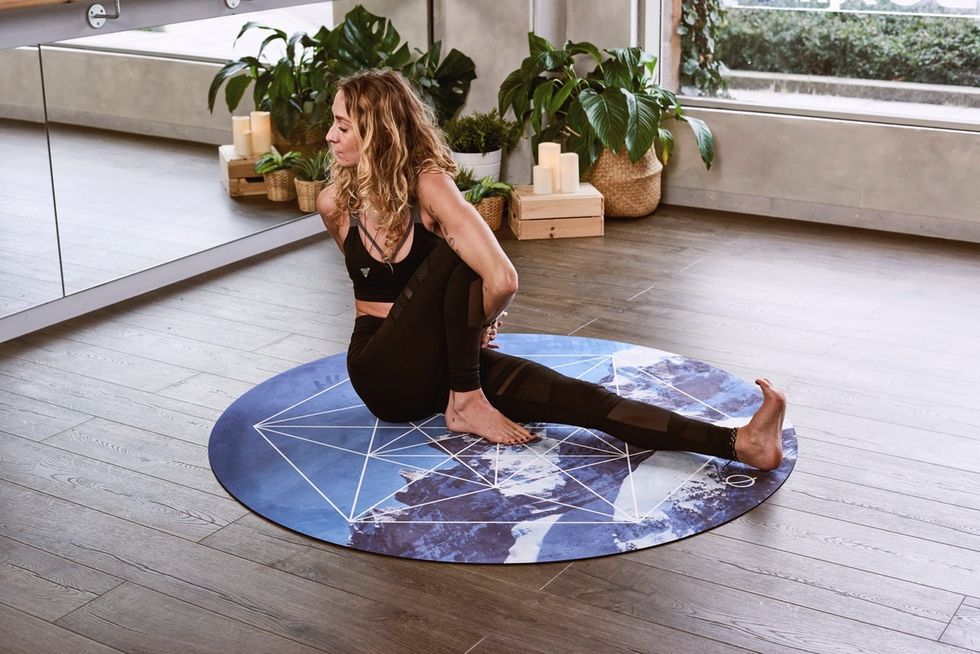Whether you're new to yoga or you've been to your share of group classes, this post will teach you about some of the different schools of yoga and when you're likely to benefit from them. Here are the basics around the main schools of yoga:
1. Hatha Yoga
Hatha yoga is the kind likely most familiar to people in the West. It's a broad term for yoga involving physical poses and is a good option for beginners because the pace of the movements is slower than some of the other choices on this list. You hold each pose for a few breaths before progressing.
Consider trying a Hatha yoga class if your goal is to improve flexibility or you often feel overly stiff from a desk job.
According to the results of a small study, the participants went through a Hatha yoga program twice a week for five months and saw improvements in flexibility afterward.
2. Ashtanga Yoga
Something that sets Ashtanga yoga apart from other types is that it matches certain movements to your breath and you do them in the same order each time. There are six groups of movements (categorized as primary, intermediate and four advanced levels) and you don't move onto the next one until mastering the first.
If you're looking for a more intense type of yoga that could help you gain strength and get an excellent physical workout, try Ashtanga. People who do it say it helps them build muscle and could even be a contributor to weight loss. Since Ashtanga yoga is one of the more intense forms, it's a kind that is practiced in hot yoga studios pretty often.
Hot yoga is not a new practice but it's recently gained incredible popularity and the classes are rapidly becoming more widespread. So, if you live in a place that you imagine will have limited yoga class options, there's a good chance that you'd still be able to find a place that offers Ashtanga yoga in a temperature-controlled studio.
3. Iyengar Yoga
Do you struggle with chronic back pain and notice that the problem negatively impacts the things you like to do? If so, Iyengar Yoga could help. It's a specific kind of Hatha Yoga that focuses on maintaining the body's alignment while controlling its breath.
Plus, there's no need to worry about initially having trouble holding the poses properly. People who take part in Iyengar Yoga often depend on props such as belts or blocks to help them perform the poses, making the risk of strain goes down. Give this type of yoga a try if you have limited mobility or are recovering from an injury, too. It's highly adaptive and teachers can modify the movements to meet your needs.
4. Bikram Yoga
Bikram yoga is the original kind of hot yoga. Bikram Choudhury founded it several decades ago and developed a system of going through 26 yoga poses and two breathing exercises per 90-minute session. All classes occur in a room kept at least 95 degrees Fahrenheit with a humidity level of around 40%.
This is the best yoga method to try if you're feeling confident in your abilities and aren't a complete beginner. It could also be a good pick for you want to focus on heart health. Research showed that people in an experiment had improved blood vessel health after doing Bikram yoga. But, one surprising conclusion of the study was that the temperature of the room did not affect those benefits.
So, if you like the Bikram yoga poses but get a bit overwhelmed by the sweltering environment, consider doing the poses at home in a setting with less intense temperatures.
5. Kundalini Yoga
Kundalini is a holistic, comprehensive type of yoga that combines movements and meditation. It uses kriyas, which are groups of postures, breaths, and sounds meant for specific outcomes. Each kriya has instructions about how long to hold each pose and even how to focus your gaze. So, if consistency comforts you, Kundalini yoga could meet your needs.
Research also shows a link between Kundalini yoga and improvements in memory. A small study of older adults revealed that when combined with separate meditation, weekly Kundalini yoga was as effective as memory enhancement training (such as crossword puzzles) for boosting performance on verbal memory tasks.
Having a better memory brings advantages at any age and there's no harm in reaping them when you're younger.
6. Kripalu Yoga
When life feels overwhelming and you need relief, Kripalu yoga could help you discover inner peace. It teaches you to develop an inner focus while paying attention to your body's limits. But, instead of getting frustrated by poses that are too hard for your current capabilities, you'll learn to listen to your body and not push it too hard.
As such, Kripalu yoga could help you develop a more positive body image. It also emphasizes that you should love everything about yourself. That's hard sometimes, especially if you're extremely self-motivated and perhaps too hard on yourself.
By becoming a Kripalu yoga devotee, you could realize that it's possible to tap into an internal stillness whenever you feel life's pressures.
This list shows that even if you make a general statement such as "I do yoga," a person cannot automatically tell precisely what's meant by that unless you go into more specifics about the types you prefer. When you want to venture into the world of yoga for the first time or spice up your routine with a new practice and movement, this can help to navigate you on where to go.
- How Yoga Changed The Way I View Workouts ›
- Top 5 Benefits of Yoga for Men ›
- 7 Reasons You Should Give Yoga A Try ›
- 4 Ways Yoga Has Improved My Life ›
- None ›



















